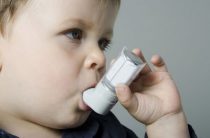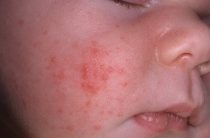In this article, we will consider the causes, symptoms, and other points of an important ailment that overtakes little peanuts. Its name is Milk Allergy in Children. Very often, from almost every parent, you can hear the following saying: "Drink, children, milk and you will be healthy." Undoubtedly, milk is a product rich in many vitamins, fats, minerals, proteins, calcium necessary for the body.
But what if this healthy drink only brings harm? Will such a reaction be able to pass years later, when the child grows up a little?
Details about allergies
According to statistics, about ten percent of children under the age of 1 year old suffer from such an ailment as an allergy to dairy products. It is no secret that an allergic reaction is an immune response to an unfamiliar, foreign antigen protein entering the body. If we talk about cow's milk, it contains about 25 of these antigens. Now let's give an example of the most active antigens. These include:
- serum albumin;
- casein;
- lactoglobulin;
- alpha lactoglobulin
- beta lactoglobulin.
Now let's find out what is the structure of the protein? So, its structure is the so-called chain, the components of which are links in the form of amino acids. After entering the gastrointestinal tract, various enzymes begin to influence the chain, which lead to its breakdown into individual elements. Note that after that the body assimilates them very easily.
The child's digestive system is completely immature, there may be a lack of enzyme substances. In this case, the chain will not be able to completely collapse, so it will consist of several links at the same time. Such structures cannot be absorbed in the intestines. As a result, the child's immune system gives a response signal, which is called an allergy.
What is a milk allergy?
This concept means that if children who have an immature enzymatic system drink some milk (this may be breast milk), their body will not be able to cope with the incoming proteins.
Pseudoallergy
Usually there is no lack of enzymes, they function well, but the baby drank a huge amount of milk, which caused difficulty in the digestive system. Excessive protein load will make itself felt even in a child with a healthy body, will cause an allergic reaction. In this situation, the allergy was provoked by a large amount of milk, and not by the nature of this product.
Intolerance vs Allergy: What's the difference?
An allergy is an immune response to an incoming foreign protein. With regards to intolerance, it is a difficulty in the digestion of milk, in which the immune system does not take any part.
Risk factors
Allergy to milk occurs as a result of non-acceptance of protein or lactose (milk sugar) by the body. Among the reasons are:
- genetic predisposition;
- mother's tendency to allergies;
- artificial feeding;
- stress during gestation;
- poor nutrition during pregnancy;
- living of the expectant mother in a poor ecological environment.
Symptoms
All systems and organs of the child are involved in milk allergy in a child, since substances that provoke the development of the disease move through the circulatory system. Note that allergies can overtake both children on artificial feeding, and those who are breastfed by their mother. Rarely, but respiratory disorders can occur. Obvious signs include:
- sneezing
- labored breathing;
- wheezing, which can become an impetus to swelling of the ligaments of the larynx (the disease is called laryngospasm). As soon as the child takes a breath, he immediately begins to suffocate.
- allergic rhinitis.
Often an allergy to cow's milk protein in a child is provoked by bronchial asthma.
Features of the gastrointestinal disorder
Allergy symptoms will be as follows:
- vomiting, nausea;
- in infants - regurgitation (often observed, in copious amounts);
- bloody streaks, curdled milk, undigested food particles are found in the stool.
Antibodies of the body attack milk proteins, therefore antigens, intestinal mucosa are damaged. As a result, the child begins to have pain in the tummy. Mostly babies cry, act up, are in a restless state. This condition should be differentiated from colic.
It is important to know that this reaction will occur only if cow's milk or another fermented milk mixture based on this milk enters the baby's body. The products used by the mother can cause allergies. Mom's milk itself cannot cause allergies (or this happens extremely rarely).
Pain in the epigastrium means that the level of hydrochloric acid in the stomach has increased. This symptom occurs due to the release of histamine, observed in various types of allergies. Pain can be chronic in children over the age of 1 year if they constantly consume dairy products. Pain is a short-term phenomenon that manifests itself near the navel of the child. The manifestation of intestinal colic, signs of colitis, impaired intestinal motility is not excluded.
Other effects of allergies
An allergy to milk reduces the quantitative indicator of beneficial bacteria - bifidobacteria, located in the intestines. Instead, representatives of opportunistic flora, for example, enterococci, Escherichia coli, and other microorganisms, begin active growth and reproduction. This negatively affects the general well-being of children.
Such an ailment as secondary enzyme deficiency will develop if the allergy to milk does not disappear for a long time. With allergies, pancreatic enzymes are produced poorly, and in small quantities. Also, an allergic reaction is the cause of impaired absorption:
- lactose;
- gluten found in cereals.
Skin condition
This allergy provokes damage to the skin of the child. Now let's talk about the features of the manifestation of each of the possible ailments. If a rash appears on the baby's body, the appearance of red spots is noted - it means that he has allergic diathesis. Itching of the cheeks and buttocks is also noted.
When the next stage occurs - childhood eczema, blisters form, then erosion, producing a colorless (clear) liquid called exudate. Then the wounds heal, the formation of crusts, scales that itch and irritate the child. Children's eczema is most often found in children up to six months.
The final stage of allergy is considered to be skin lesions, which is called atopic dermatitis. Its characteristic feature is severe itching, which manifests itself more intensely in the evening, at night, which does not allow the child to sleep in a calm, sweet sleep. Dermatitis is localized in the knee, elbow bends. In adolescence, the skin of the neck and face is affected.
Among the reasons are:
- malnutrition, daily routine;
- immature digestive system.
Another blame falls on the shoulders of the mother if she led the wrong way of life. Usually, doctors prescribe medications for oral administration (to help slow down the inflammatory process), external use (to help eliminate symptoms). In order to prevent a pregnant woman, a balanced diet is shown. Nursing mothers are advised to follow a hypoallergenic diet.
Signs on the face
An allergy to milk is often the cause of a rash, redness, and roughness of the skin. They are not particularly dangerous, but can adversely affect the respiratory system. Factors that cause such an allergy are any food containing chemical additives, flavoring substances. Also, the cause may be direct contact with plant pollen, various animals.
Symptoms of an allergic reaction can appear half an hour after the penetration of the allergen into the child's body. Let's say it was a product that the baby ate. Often this does not affect the general well-being, but it manifests itself on the face. To cure the disease, you need to consult a doctor in time. He will advise ointments, creams that help moisturize the skin, get rid of rashes, roughness. In addition, the doctor will begin to find out, then eliminate the exact cause of the disease. Compliance with simple rules of hygiene plays an important role.
Diagnostics
Suspicious symptoms are a reason to go to the doctor as soon as possible. He will prescribe various types of examinations, identify the cause of the disease, and then prescribe adequate individual therapy. A very accurate method is skin tests with an allergen. Sometimes a substance similar to it is used. Most often, it is possible to identify an allergic reaction to milk through this method.
If skin tests were negative, the level of immunoglobulin E is normal, a food test is prescribed to make sure that this disease is absent. The doctor needs to tell all the symptoms that bother the child. This will make it possible to find differences among such ailments as an allergy to milk protein and lactase deficiency, because they both have similar symptoms (liquid feces, colic, regurgitation, bloating).
simple test
To determine what exactly the child is suffering from (he has an allergic reaction to protein or lactase deficiency), the doctor prescribes an easy test. You need to be lactose-free for a few days. That's why:
- an infant on artificial nutrition is transferred to mixtures that do not contain lactose;
- if the baby eats mommy's milk, women are advised to give up all products containing lactose;
- older children are shown a ban on the use of dairy products, milk.
If the signs of the disease disappear in a short time, then it is the lack of lactose that caused the allergy. Note that the so-called milk allergy often worries children under 3 years old, then disappears on its own. The baby is able to acquire lactase deficiency throughout life, or already be born with it. An ailment appears after the peanut suffers certain diseases (rotavirus infections, giardiasis of the intestine). If the causes of the disease are such, getting rid of them is simple: you need to follow a diet.
Treatment
After an accurate diagnosis, the baby is no longer fed with milk and other dairy products. They are also forbidden to be eaten by mothers. If the diet does not help, use mixtures that do not contain cow's milk proteins, since they contain soy or goat's milk protein in a split form. The transition to such mixtures is carried out gradually. Doctors advise starting to feed children with dairy products after they grow up to six months.
Initially, complementary foods should consist of sour-milk products. If you are allergic to them, you should wait six months, try again. It is best to continue breastfeeding as long as possible. If this is not enough, you can use bait mixtures that do not contain cow's milk. Mixtures based on hydrolysates and soy are also allowed.















